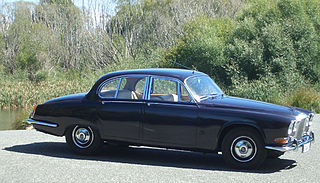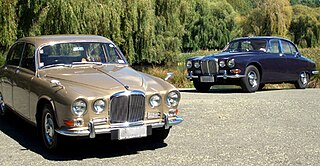
Jaguar is the sports car and luxury vehicle brand of Jaguar Land Rover, a British multinational car manufacturer with its headquarters in Whitley, Coventry, England. Jaguar Cars was the company that was responsible for the production of Jaguar cars until its operations were fully merged with those of Land Rover to form Jaguar Land Rover on 1 January 2013.

A hemispherical combustion chamber is a type of combustion chamber in a reciprocating internal combustion engine with a domed cylinder head notionally in the approximate shape of a hemisphere. An engine featuring this type of hemispherical chamber is known as a hemi engine.

The Jaguar E-Type, or the Jaguar XK-E for the North American market, is a British front mid-engined sports car that was manufactured by Jaguar Cars Ltd from 1961 to 1974. Its combination of exceptional aesthetics, advanced technologies, high performance, and competitive pricing established the model as an icon of the motoring world. The E-Type's claimed 150 miles per hour (240 km/h) top speed, sub-7-second 0 to 60 mph (97 km/h) acceleration, largely unitary body construction, front and rear independent suspension with disc brakes, mounted inboard at the rear, and rack-and-pinion steering, distinguished the car and spurred industry-wide changes.

The Jaguar XK150 is a sports car produced by Jaguar between 1957 and 1961 as the successor to the XK140.

The Jaguar XJ is a series of mid-size/full-size luxury cars produced by British automobile manufacturer Jaguar Cars from 1968 to 2019. It was produced across five basic platform generations with various updated derivatives of each. From 1970, it was Jaguar's flagship four-door model. The original model was the last Jaguar saloon to have been designed under the leadership of Sir William Lyons, the company's founder, and the model has been featured in countless media and high-profile appearances.

Coventry Climax was a British forklift truck, fire pump, racing, and other speciality engine manufacturer.

The Jaguar AJ-8 is a compact DOHC V8 piston engine used in many Jaguar vehicles. It was the fourth new engine type in the history of the company. It was an in house design with work beginning before Ford's purchase of the company. In 1997 it replaced both designs previously available on Jaguar cars: the straight-6 Jaguar AJ6 engine, and the Jaguar V12 engine. It remained the only engine type available on Jaguar until 1999 with the launch of the S-Type, when the Jaguar AJ-V6 engine was added to the list. The AJ-V8 is available in displacements ranging from 3.2L to 5.0L, and a supercharged version is also produced. Ford Motor Company also used this engine in other cars, including the Lincoln LS and the 2002–2005 Ford Thunderbird, as well as in several Land Rovers, and the Aston Martin V8 Vantage.

An evolution of the 1964 DOHC prototype “XJ13” engine, the Jaguar V12 engine is a family of SOHC internal combustion V12 engines with a common block design, that were mass-produced by Jaguar Cars for a quarter of a century, from 1971 to 1997, mostly as 5.3‑litres, but later also as 6‑litres, and 7‑litre versions that were deployed in racing. Except for a few low-volume exotic sports car makers, Jaguar's V12 engine was the world's first V12 engine in mass-production. For 17 years, Jaguar was the only company in the world consistently producing luxury four-door saloons with a V12 engine. The V12 powered all three series of the original Jaguar XJ luxury saloons, as well as its second generation XJ40 and X305 successors.

The AJ6, and the similar AJ16, are inline-6 piston engines used by Jaguar cars in the 1980s and 1990s. The AJ6 was designed to replace the successful and long-used Jaguar XK6 engine, and was introduced in 1984. It was only the third all-new engine ever designed by the company. The AJ16 evolution was replaced in 1996 with the Jaguar developed AJ-V8 engine.

The Jaguar Mark X, later renamed the Jaguar 420G, was British manufacturer Jaguar's top-of-the-range saloon car for a decade, from 1961 to 1970. The large, luxurious Mark X not only succeeded the Mark IX as the company's top saloon model, but radically broke with both its predecessor's styling and technology.
The Lanchester Motor Company Limited was a British car manufacturer in active trade between 1899 and 1955. Though the Lanchester Motor Company Limited is still registered as an active company and accounts are filed each year, the marque has been dormant since. As of 2014 it is marked as "non-trading".

The Jaguar Mark IX is a four-door luxury saloon car announced 8 October 1958 and produced by Jaguar Cars between 1958 and 1961. It was generally similar to the Mark VIII it replaced, but had a larger, more powerful 3.8 litre engine, 4-wheel disc brakes, and power assisted recirculating ball steering among its mechanical improvements.

The Jaguar S-Type is a saloon car produced by Jaguar Cars in the United Kingdom from 1963 to 1968. Announced 30 September 1963 it was a technically more sophisticated development of the Mark 2, offering buyers a more luxurious alternative without the size and expense of the Mark X. The S-Type sold alongside the Mark 2, as well as the Jaguar 420 following its release in 1966. A retro-styled vehicle with the same name was also produced, based on the design of the original S-Type vehicles.

The Jaguar Mark 2 is a mid-sized luxury sports saloon built from late 1959 to 1967 by Jaguar in Coventry, England. The previous Jaguar 2.4 Litre and 3.4 Litre models made between 1955 and 1959 are identified as Mark 1 Jaguars.

Daimler V-8 engines were designed for the Daimler Company by Edward Turner and produced from 1959 to 1969. Initially used in the SP250 sports car and the Majestic Major saloon, the engine was mostly used in the Daimler 2.5 V8 saloon made with Jaguar Mark 2 unit bodies from 1962 to 1969. Approximately 20,000 of the 2.5-litre version of the engine were made for use in the SP250 and the 250 saloon, while approximately 2,000 of the 4.5-litre version were made for use in the Majestic Major saloon and its limousine variant which remained in production until 1968.

Daimler Sovereign was a name applied by British manufacturer Jaguar Cars to a sequence of luxury automobiles built by it but carrying the Daimler badge between 1966 and 1983.

The Jaguar Mark VIII is a luxury four-door automobile introduced by the Jaguar company of Coventry at the 1956 London Motor Show.

William 'Bill' Munger Heynes CBE, born in Leamington Spa, was an English automotive engineer.

The Jaguar 420 and its Daimler Sovereign equivalent were introduced at the October 1966 London Motor Show and produced for two years as the ultimate expression of a series of "compact sporting saloons" offered by Jaguar throughout that decade, all of which shared the same wheelbase. Developed from the Jaguar S-Type, the 420 cost around £200 more than that model and effectively ended buyer interest in it, although the S-Type continued to be sold alongside the 420/Sovereign until both were supplanted by the Jaguar XJ6 late in 1968.

The Jaguar XJ (X350) is a full-size four-door luxury saloon car manufactured and marketed worldwide by Jaguar Cars for model years 2003–2009 as the third generation of the Jaguar XJ saloon, carrying the internal designation X350 and the internal designation X358 following its 2007 intermediate facelift. Both the X350 and X358 were available with a six-speed automatic transmission, a range of petrol and diesel engines, numerous trim levels, and short wheelbase (2003–2009) or long wheelbase (2005–2009) car body configurations. Extended-length models were the longest vehicles Jaguar had manufactured.























